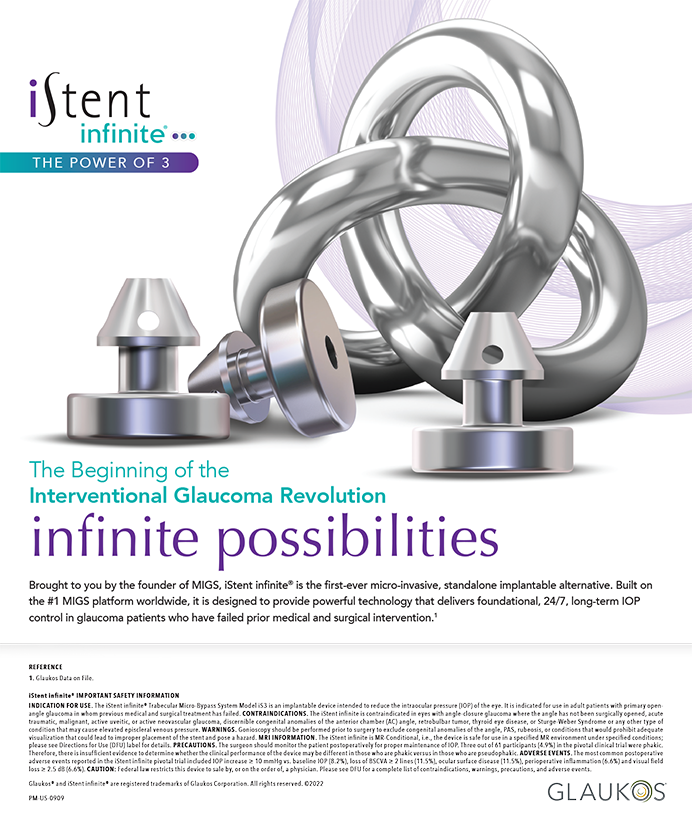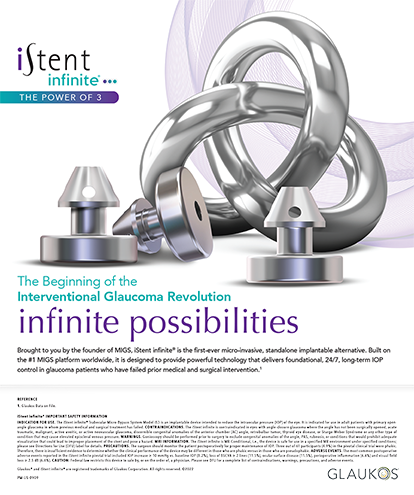Presbyopia, an inevitable byproduct of aging, results in the loss of people’s ability to instantaneously change their focal distance and usually manifests as trouble reading. Over the years, many different approaches have been devised to correct this condition, including the use of appliances such as multifocal lenses and blended lenses as well as monovision and bifocal contact lenses. Although effective, these options do not offer the freedom from spectacles and contact lenses that some patients desire.
The surgical correction of presbyopia began almost 30 years ago in the form of RK and then keratomileusis. Next, surgeons began to use various laser platforms for a monovison technique that typically leaves the patient’s nondominant eye somewhat nearsighted, depending on his or her near visual requirements and tolerance of anisometropia. Monovision is very effective and provides good distance and near ability for most patients, but the approach has its limitations. Monovision can have a negative effect on distance vision as well as depth perception and induce anisometropia, which can be unacceptable to some patients. Presbyopia-correcting IOLs have gone a long way toward eliminating or minimizing presbyopic complaints, whether the lenses work by creating mulitifocality or change in a focal distance through movement or flexing of the IOL. This type of change requires an intraocular intervention, there can be visual symptoms, and it does not address the early presbyopes who are reluctant to undergo intraocular surgery.
A laser-based solution to presbyopia would be of significant benefit to patients with presbyopia and could greatly affect the presbyopic market.
POSSIBILITIES
Information gathered over the last 10 to 15 years has made laser solutions possible. For example, clinicians now know that negative spherical aberration is a normal component of the accommodative process in young adults (Figure 1). This aberration decreases the retinal blur circle and increases the depth of field. In addition, surgeons have learned that they can induce negative spherical aberration by creating a prolate cornea with a negative Q-value of approximately -0.6 to -1.0. This goal has been made possible by the development of scanning-spot lasers with excellent tracking, treating the peripheral cornea adequately by accounting for loss of laser ablation in the periphery by reflection and ovalization of the beam, and excimer lasers that can create seamless blend zones. All of these characteristics were built into the initial design of the WaveLight Allegretto laser (Alcon Laboratories, Inc., Fort Worth, TX).
PRESBY-LASIK
Roberto Pinelli, MD, originally described his technique of presby-LASIK, which he calls presbyopic multifocal LASIK or PML, using the Technolas laser (Bausch + Lomb, Rochester, NY). With this technique, the surgeon effectively overcorrects the patient’s initial refractive error and then brings it back to plano—with treatments of different optical zones, a larger hyperopic treatment, and then a smaller myopic treatment—to create a prolate cornea and a central distance correction that is minimally dependent on the pupil’s size. Approximately 1.5 years ago, under Dr. Pinelli’s guidance, my colleagues and I adapted his technique to the WaveLight laser. This is an off-label procedure in the United States, and appropriate informed consent needs to be obtained from the patient. We perform a myopic treatment at a 5.5-mm optical zone followed by a 6.0-mm optical zone hyperopic correction, which overcorrects the patient’s initial refractive error by 1.00 to 2.25 D. We then achieve a plano result through the opposite treatment at the different optical zone. Presby-LASIK is effective for a range of refractive errors -5.00 to +3.00 D, with up to 3.00 D of cylinder. This procedure is effective in emme-tropes as well, so its range of applications is greater than that of most other available laser treatments.
My colleagues and I have now treated 500 patients, and surgeons at other centers around the country have operated on another 200 or so patients. The results have been excellent, and patients’ satisfaction has been very high and consistent between centers. At our facility, no patients have lost BSCVA. Other concerns such as night vision problems and glare have not been an issue and certainly no different than for our nonpresbyopic laser patients, according to data obtained from our postoperative questionnaire. Our enhancement rate is higher, in the range of 8% to 10%, but we feel this will decrease as we fine-tune our nomograms. As indicated in Figures 2 and 3, uncorrected binocular distance visual acuity is 20/25 in 95% of patients at 6 months and is very stable at that point. Uncorrected binocular near vision is J3 in 95% of patients, which again seems to be stable by 3 to 6 months. We achieve these results by creating a prolate shape with a negative spherical aberration and a negative Q-value (Figure 4).
CONCLUSION
Presby-LASIK provides patients’ with adequate functional near vision while maintaining good distance visual acuity through the creation of an optically superior corneal shape. Is the procedure the perfect solution to presbyopia? Of course not. Nothing short of restoring patients’ full accommodative amplitude will be optimal. Fortunately, surgeons are working with a physiologic optical system that is pliable and adaptable and allows for compromises.
For my colleagues and me, presby-LASIK has been a valuable addition to our laser practice. The procedure now accounts for about 35% of our laser surgeries and permits our patients a wider range of presbyopia-correcting solutions.
Michael Gordon, MD, is a partner in the Gordon & Weiss Vision Institute in San Diego. He is a consultant to Alcon Laboratories, Inc. Dr. Gordon may be reached at mgordon786@aol.com.


